Fabrication
Fabrication of the manipulator occurs in three distinct steps, each detailed in one of the following pages:
1. Design and 3D print the mold for the manipulator
2. Coil and anneal the artificial muscles
3. Pour the mold and embed the muscles
The required materials are listed below:
- Ecoflex™ 00-10 silicone, parts A and B
- Silver-coated nylon thread, at least 2 m length
- 12V DC motor
- DC power supply (capable of at least 12V and 2A)
- Brass weights
- Metal clamp stand (shown in muscle coiling section)
- Binder clips (at least 4)
- Thin carbon fiber rods, no larger than 1 mm in diameter
- Oven capable of 150°C
- ABS plastic filament and access to 3D printing
- Measuring cup and mixing tools (such as spoons)
- Various common tools (can be helpful: e.g. a flathead screwdriver for removal from mold)
Mold Design and Printing
Before fabrication can begin, a mold must be created. The easiest way is by designing a mold using CAD software and 3D printing it.
Due to the relative weakness of the artificial muscles that are used, the scale of this actuator must be small. For example, the final mold we designed produces a rectangular manipulator that is 35 mm in length, 8 mm in width, and 6 mm in depth. This permits the manipulator to execute noticeable bending when a voltage is applied.
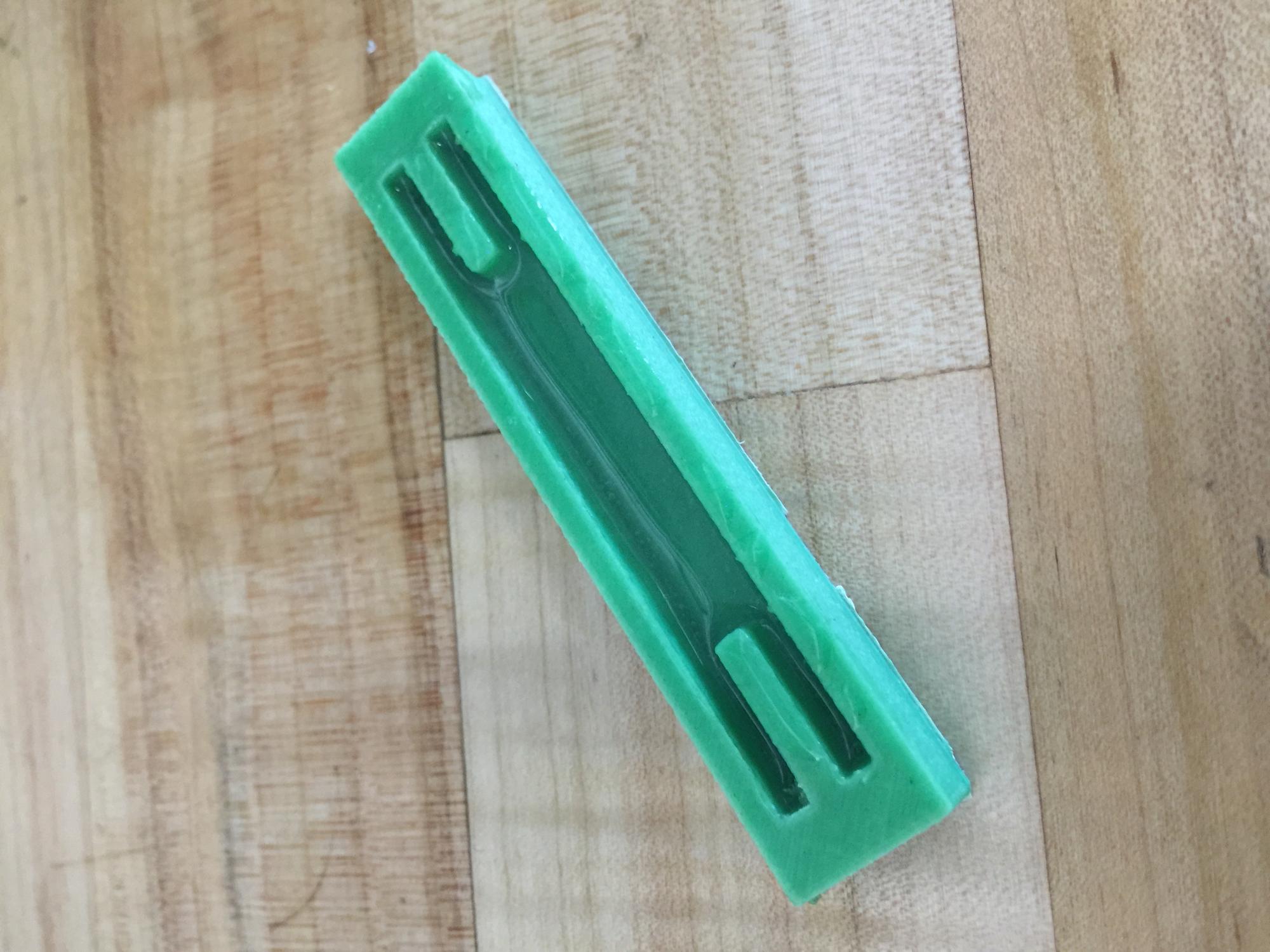
At its simplest, the mold should consist of a rectangular block with a rectangular cavity in one face that is the intended size of the manipulator (this is where the silicone is poured). One dimension of the manipulator should greatly exceed the other two, as in our design, where the length is almost four times the width.
Two narrow channels should be designed into each end of the mold, allowing the two artificial muscles to extend out of the mold during silicone pouring. The channel width should be at least 2 mm, and the channels should be symmetric about the centerline of the manipulator. To prevent leakage of silicone out the ends, the channels should be enclosed, as in the above image.
Since 3D printers and printing methods vary, we cannot give step-by-step instructions. It is important to use a printer capable of a resolution finer than the most detailed aspects of the design, and to avoid unnecessary features that will be difficult for the printer to replicate. We used ABS plastic filament and found its balance between rigidity and toughness suitable for this project.
Coiling of Artificial Muscles
Fabrication of the nylon thread-based artificial muscles requires a special apparatus, shown below. This includes a metal clamp stand, a DC power supply with alligator clip leads, a 12-volt DC motor, an oven capable of 150°C, brass weights, binder clips, Teflon nonstick spray, and thin cylindrical carbon fiber rods (no larger than 1 mm in diameter), in addition to conductive (we used silver-coated) nylon thread. Thread size can vary, with thicker thread producing muscles with greater strength; we used thread about 0.5 mm thick.
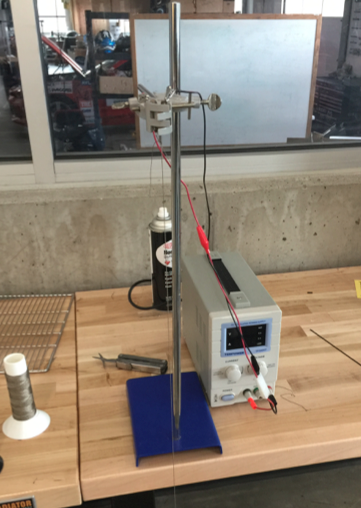
Muscle coiling apparatus
The motor, clamped at the top of the metal stand, should have a hole drilled through the side of its shaft, such that two threads can be run through and tied to secure them (see below), and a second hole drilled to a depth of about 5 mm into the end of the shaft, with sufficient diameter to insert a carbon fiber rod. At this stage, the motor’s shaft should be vertical, pointing downward, with two lengths of thread (each approximately 0.4 meters) strung through the shaft and tied twice at the end. Tie a weight (or group of weights, depending on the thread gauge; we used 135 grams) to the bottom of the lengths of thread, and let the system hang free. Using your hands or some other means, you must ensure that the weight at the bottom does not rotate during the next several steps; to accomplish this, we used wire to link the weight to one of the legs of the table without fully restraining vertical motion.
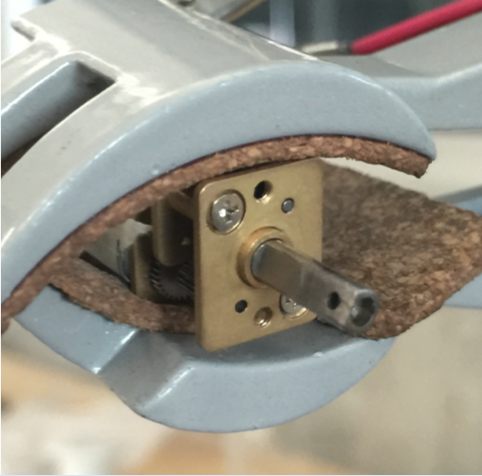
Motor for coiling apparatus clamped into stand. Holes have been drilled in the end and side.
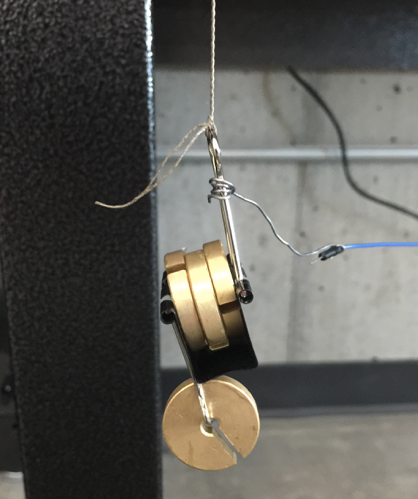
Weights tied to end of thread for coiling
Preheat the oven to 150°C and carefully coat two 15 cm lengths of carbon fiber rod with Teflon spray (important for facilitation of muscle removal later). Ensure that the power supply is set to provide 7 V, direct current. With the power supply off, attach the leads to the motor and then turn the power supply on, causing the motor to spin. To permit twist in the thread, ensure that the weight at the bottom does not rotate. Keep the motor running until coils just begin to form at the top or bottom of the thread, and then stop the motor, still making sure that the weight is not allowed to spin.
Now, rotate the clamp of the stand so that the motor's shaft is pointed just a few degrees above horizontal with the thread still hanging off the end and with the weight’s rotation prevented. Insert one of the carbon fiber rods that was Teflon coated into the end of the shaft, such that its long axis and the axis of rotation of the motor coincide. Reverse the leads to the motor and set the power supply to 1.5 V, which will cause the motor to rotate in the opposite direction. Taking care to support the carbon fiber rod with your hands, and still restraining rotation of the weight, turn the power supply on.
The rotation of the motor will cause the thread to wrap around the rod. As the rod is thin and not very strong, you must provide steady support at a point very close to where the thread hangs off of the rod to prevent a fatal bending load from the weight. In supporting the rod this way, you additionally ensure that successive wraps around the rod are very close together; however, you must make sure that the thread never wraps around itself. The image below shows this process near completion.
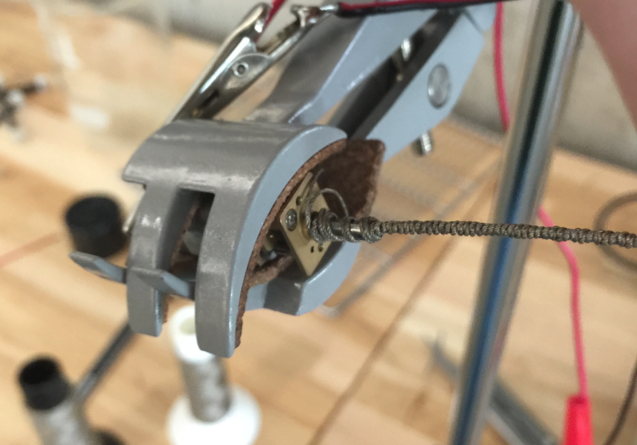
Thread wrapped several centimeters onto rod
Once wraps of thread cover a length of rod at least 1 cm greater than the length you designed for the manipulator, turn off the motor (still supporting the rod and preventing rotation of the weight). Use binder clips to pinch the thread at each end of the rod, and then cut the thread off from each end, freeing the weights and removing the rod from the motor. Repeat all of the above steps to produce a second muscle, and then place both rods with binder clips and thread still on in the oven for annealing.
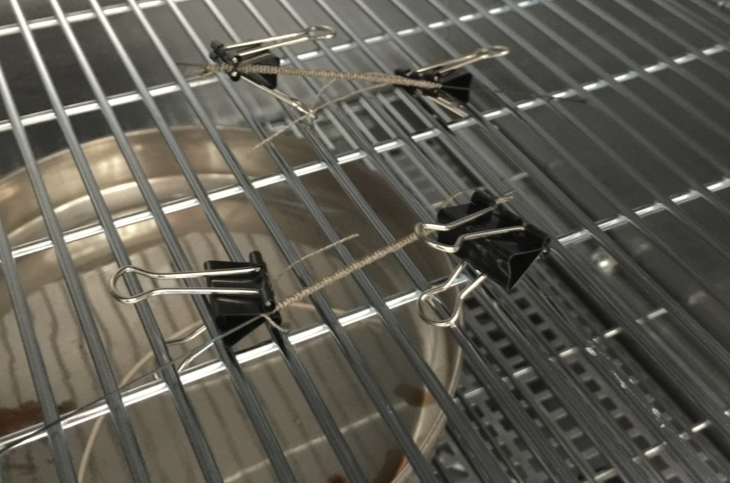
Two muscles annealing in oven
After one hour in the oven, carefully remove the rods. Allow them to cool completely, about 10 minutes, and then remove the binder clips and thread from the rod, making sure not to stretch out the coils. This may require using a pair of pliers to push the muscle off from one end. The final product of this stage is the coiled and annealed thread, which will be embedded in silicone (in the next section).
Muscle Embedding and Mold Pouring
From the previous section, you should have two extension muscles, each slightly longer than the designed manipulator. For this section, you need Ecoflex™ 00-10 (which comes as two jars of liquid, labeled parts A and B), and a container for mixing, alongside spoons or other mixing utensils.
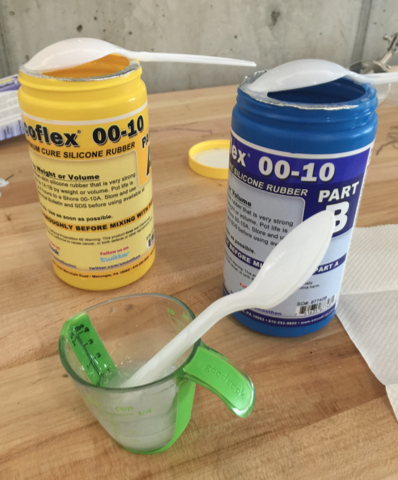
Ecoflex™ silicone and mixing container we used
Measure the radius of the muscles you fabricated as well as the depth of the mold. Before placing muscles into the mold, it is necessary to fill the mold to a certain level with silicone so that the muscles can be centered in the manipulator. Specifically, this level is one muscle-radius below the halfway point of the depth of the mold. Place a mark at this level using a pen or marker.
After stirring both parts of Ecoflex™ thoroughly in their jars (using separate stirring utensils), pour equal parts A and B into the mixing container, with at least enough to fill the mold (about 1 fluid ounce was plenty for ours). Stir this mixture (using another separate stirring utensil) for a full three minutes, taking care to scrape the sides and bottom several times during mixing. Carefully pour this mixture into the mold, up to the level previously specified. Allow this to cure; although the full four hours is not necessary, the silicone must be solid enough to prevent the muscles from sinking in.
Lay the muscles into the mold on top of the previously poured silicone so that they run parallel, each running through its own channel at the ends of the mold. Prepare another batch of silicone as done previously and pour it on top of the muscles until the mold is full. After the pour has settled, use a small instrument (like the carbon rod from before) to straighten out the muscles if they have developed curves during mold pouring, and additionally to ensure the top surface is level. Let the mold sit in room temperature.
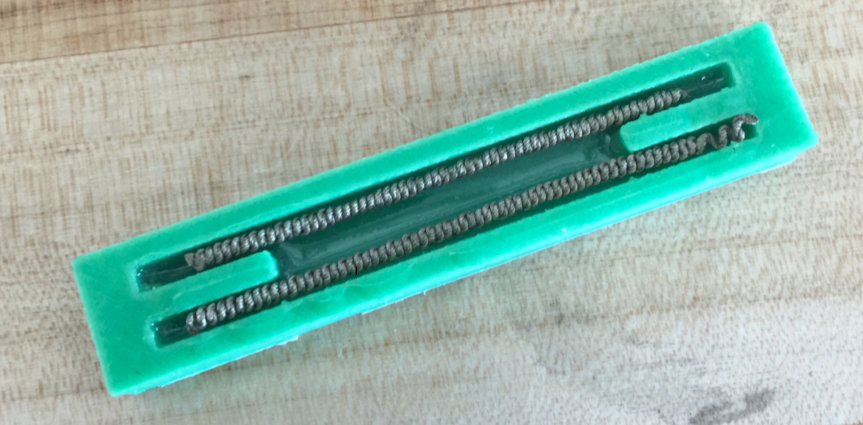
Mold with muscles laid in, prior to silicone pouring
After four hours, carefully pry the manipulator from the mold interior (a flat-head screwdriver may help).
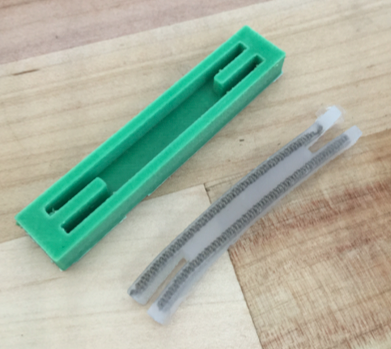
Finished manipulator, removed from mold
Finally, using a small pair of scissors, remove the silicone from the ends of the muscles (where the channels were), careful not to pull the muscles out of the manipulator body or cut the ends of the muscles off. This is only necessary to allow an attachment point for the power supply leads during testing.